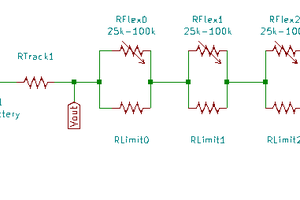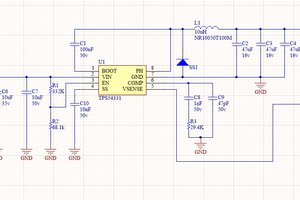Overview
Twelvey provides a compact control voltage interface for one “octave” of musical notes. Twelve voltage divider circuits send distinct voltages through a common output port.
Technical Details
This device contains twelve parallel voltage divider circuits, each providing between +5V and +6V of “control voltage” for a CV-based sound synthesizer. By adding “keys” (e.g., momentary button switches), this circuit will approximate the 1V/Oct implementation common on several analog synthesizer platforms, as follows:
Keys | Input Voltage (V) | Output Voltage (V) |
1 | 9 | 5.00 |
2 | 9 | 5.09 |
3 | 9 | 5.18 |
4 | 9 | 5.27 |
5 | 9 | 5.36 |
6 | 9 | 5.45 |
7 | 9 | 5.55 |
8 | 9 | 5.64 |
9 | 9 | 5.73 |
10 | 9 | 5.82 |
11 | 9 | 5.91 |
12 | 9 | 6.00 |
Audio output may or may not equate to a true musical “octave;” this device can be connected to any number of possible synthesizers under any number of possible conditions. The output should, however, constitute twelve distinct voltages, increasing regularly from lowest to highest, which may approximate an octave-like scale.
Rating | Designator | Footprint | LCSC Part Number |
40V 3A 550mV @ 3A Schottky Barrier Diodes | D1, D2, D3, D4, D5, D6, D7, D8, D9, D10, D11, D12 | SOD-123FL | |
1KΩ Resistor | R1, R2, R3, R4, R5, R6, R7, R8, R9, R10, R11, R12, R13, R15, R16, R17, R18, R19, R20, R21, R22, R23, R24, R25 | R0603 | |
1.2KΩ Resistor | R14 | R0805 | |
220Ω Resistor | R26 | R0603 | |
100Ω Resistor | R27 | R0603 | |
330Ω Resistor | R28, R29 | R0603 | |
470Ω Resistor | R30, R31 | R0402 | |
560Ω Resistor | R32 | R0603 | |
680Ω Resistor | R33, R34 | R0603 | |
820Ω Resistor | R35, R36 | R0603 | |
30Ω Resistor | R37, R40 | R0805 | |
5.1Ω Resistor | R38 | R0805 | |
9.1Ω Resistor | R39 | R0805 | |
82Ω Resistor | R41, R45 | R0805 | |
68Ω Resistor | R42, R44 | R0603 | |
47Ω Resistor | R43 | R1206 |
General Usage
To use this device as a CV controller, connect the following:
- A power supply
- Buttons or switches
- An output jack
Additional Options
This design features a space (currently unused) for a built-in dual oscillator based on Texas Instruments’ Dual 2-Input NAND Gate With Schmitt-Trigger Inputs (SN74LVC2G132). Certain locations on the PCB (Ports 1-7, 3G, 7G, and IC SW) are designed to work with this planned feature.
 Bert Jerred
Bert Jerred
 Ghani Lawal
Ghani Lawal
 Pablo Antonio Camacho Jr.
Pablo Antonio Camacho Jr.
 Vedran
Vedran
 hesam.moshiri
hesam.moshiri